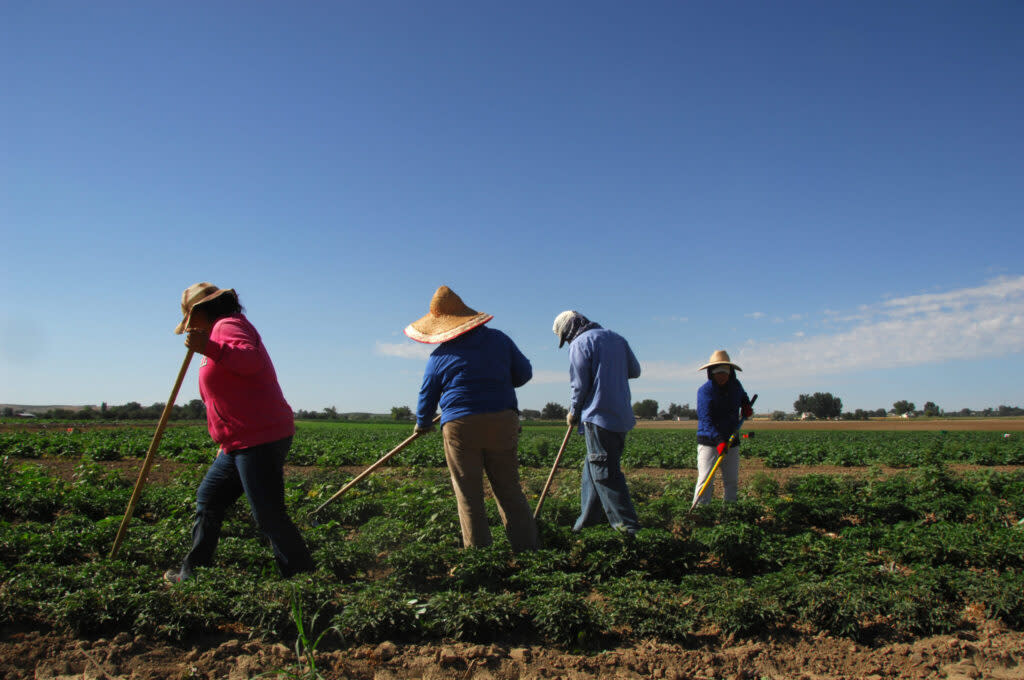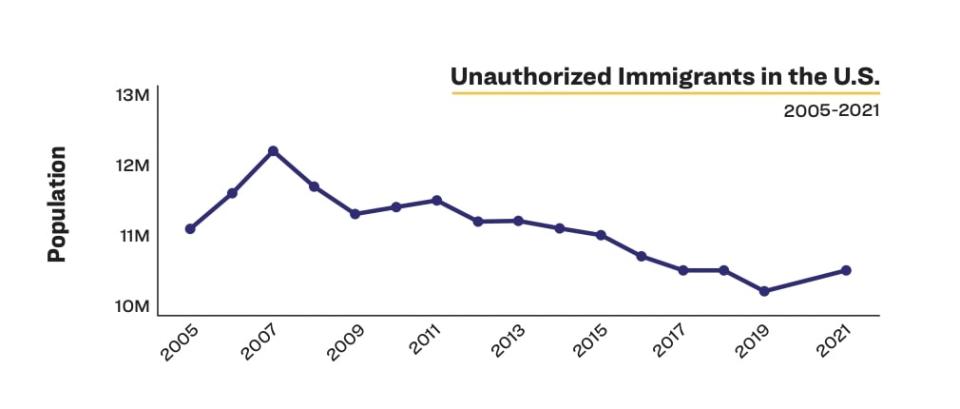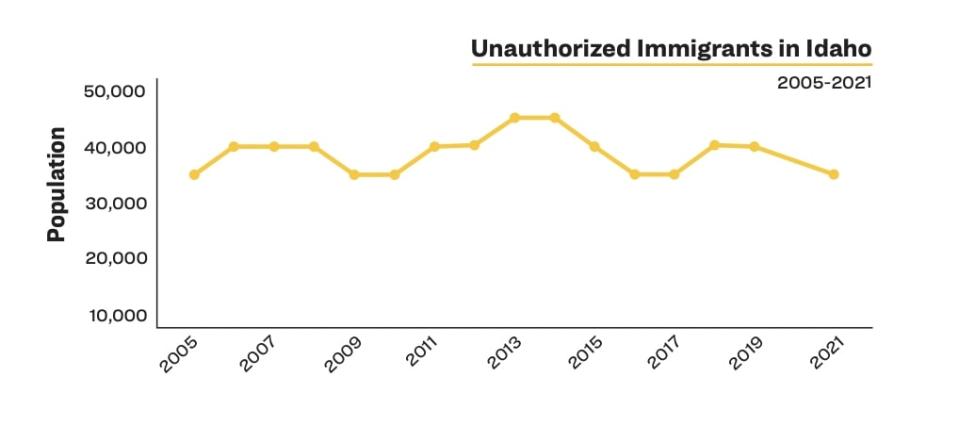Unauthorized immigrants are key players in Idaho’s economy, agricultural sector, study shows

Workers weed a field of peppers on a farm in Fruitland, Idaho. (Kirsten Strough/U.S. Department of Agriculture)
Para leer esta historia en español, haga clic aquí.
Unauthorized immigrants make up about 35,000 people of Idaho’s population, and their labor and spending contributions are in the tens of millions of dollars, according to a new report.
In June the University of Idaho’s McClure Center for Public Policy Research released a report, “Idaho at a Glance: Unauthorized Immigrants and Idaho’s Economy,” which highlights the key figures from a study about the role unauthorized immigrants have in the state’s economy.
The report was conducted at the request of the Idaho Dairymen’s Association, Idaho Farm Bureau Federation, and Idaho Association of Commerce and Industry, McClure Center director Katherine Himes told the Sun.
Himes said there were limitations to finding recent data, adding there is a “time lag” with the data available.
“Resources were not available to collect new data or update existing estimates of the unauthorized immigrant population,” she said. “The most recent data on the number of unauthorized immigrants in the United States and Idaho are from 2021, with more detailed data only available for earlier years.”
National trends, according to the report, show that the number of unauthorized immigrants living in the U.S. has decreased over the years. In 2007, there were an estimated 12.2 million living in the country. That number went down to 10.5 million in 2021.

Unlike national trends, Idaho’s unauthorized immigrant population has remained largely stable over the years, holding steady at around 35,000 between 2005 and 2021, according to the report.

Key economic figures in the report show:
Unauthorized immigrants in Idaho had an estimated $570 million available for spending in 2019.
In 2014, the most recent year for which data are available, unauthorized immigrants in Idaho paid $26.3 million in sales, property, and state income tax combined.
Unauthorized immigrants play a key role in Idaho’s economy, according to the report, and they help Idaho industries — particularly those in agriculture, hospitality and construction – meet their labor needs.
The report shows that of the unauthorized immigrants living in Idaho:
92% are working-age adults 86% are in the workforce 78% are from Mexico 58% speak English “well” or “very well” 48% have a high school diploma, some college
GET THE MORNING HEADLINES DELIVERED TO YOUR INBOX
‘We are dependent on an unauthorized workforce’: agriculture group says
While Idaho lawmakers pushed for policies targeting the state’s unauthorized immigrant population during the 2024 legislative session, at least one Idaho industry has been vocal about its need for the unauthorized immigrant workforce.
Rick Naerebout, the chief executive officer of the Idaho Dairymen’s Association, has testified several times against bills making their way through the Statehouse that would impact his industry’s workforce.
This year, at least two bills introduced in the 2024 legislative session pushed for strict immigration policies:
House Bill 615, would have prevented unauthorized immigrants in Idaho from accessing publicly-funded assistance. Bill sponsors Reps. Jordan Redman, R-Coeur d’Alene, and Josh Tanner, R-Eagle, said their goal was to disincentivize unauthorized immigrants from moving to Idaho. The bill did not move forward. In a 7-5 vote in the House Health and Welfare Committee, Democrats and Republicans said it would hurt unauthorized mothers and children who seek vaccines, prenatal care and food assistance.
House Bill 753, a replica of a controversial Texas law that would have created a new crime known as illegal entry, also made its way through the statehouse. Rep. Jaron Crane, R-Nampa, introduced the bill two weeks before the Legislature adjourned. It passed in the Idaho House of Representatives in a 53-15 vote, but it did not make it to the Senate for a hearing.
If those or other immigration-related policies were to pass in future legislative sessions, they could have major ramifications on jobs related to the state’s agricultural industry and the people who work them.
Idaho ranks third in the U.S. for its milk and cheese production, according to the Idaho Department of Agriculture. But most of those working in Idaho’s dairy industry are not legally authorized to live in the U.S.
According to the Idaho Dairymen’s Association:
90% of Idaho dairy workers are foreign-born and Spanish-speaking78% of Idaho dairy workers are from Mexico11% are from the U.S.11% are from Central America
Unlike farmwork and hospitality jobs — dairy work is year round, and workers do not have access to a visa program that allows them to work seasonally. When 90% of those working in Idaho dairy jobs are foreign born and there is a regular shortage in dairy workers, the industry relies on the unauthorized workforce, Naerebout told the Idaho Capital Sun.
“The reality is, it’s been decades since the domestic population has wanted to work the jobs that agriculture provides,” he said. “Agricultural jobs are going to be manual labor. We pay competitive wages, but they’re not easy jobs. The domestic workforce typically is going to take a pass on them and pursue other jobs that are going to be easier.”
Naerebout said he will continue to defend the dairy industry’s need for an unauthorized workforce during future legislative sessions.
Let us know what you think...
“We are dependent on an unauthorized workforce,” he said. “Who would fill that void if those workers weren’t here available to fill the jobs that other people don’t want?” he said.
Naerebout said the biggest misconception he hears about Idaho’s unauthorized workforce is that the workers have a negative impact in the communities they live in.
“Nothing can be further from the truth,” he said. “They add to society, and without those jobs we would have much less economic activity — especially in places like the Magic Valley, where that entire valley is built around food production and food processing.”
Naerebout said that the McClure Center’s report on unauthorized immigrants effectively highlights that the situation in Idaho is quite different from what is occurring at the southern border.
Idaho’s unauthorized immigrant population has remained steady over the years, and at least half of that population has been in Idaho for more than 16 years.
“They’re very stable, and they’re a part of our community,” Naerebout said.
Idaho Capital Sun is part of States Newsroom, a nonprofit news network supported by grants and a coalition of donors as a 501c(3) public charity. Idaho Capital Sun maintains editorial independence. Contact Editor Christina Lords for questions: info@idahocapitalsun.com. Follow Idaho Capital Sun on Facebook and X.
The post Unauthorized immigrants are key players in Idaho’s economy, agricultural sector, study shows appeared first on Utah News Dispatch.

